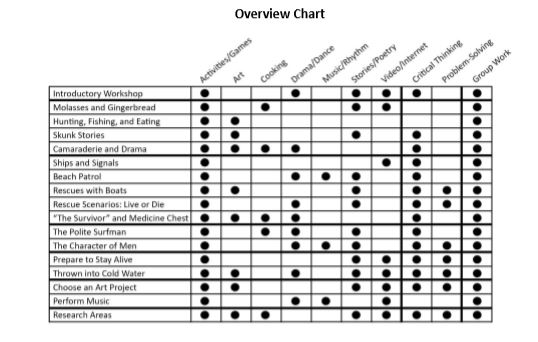Disclaimer: I recieved a FREE copy of this product through the HOMESCHOOL REVIEW CREW in exchange for my honest review. I was not required to write a positive review nor was I compensated in any other way. All opinions I have expressed are my own or those of my family. I am disclosing this in accordance with FTC Regulations.
I was so intrigued when I was offered the opportunity to review Exploring the U.S. Life-Saving Service: 1878-1916: 17 Student Workshops with 120 Activities written and published by Rebecca Locklear.
Divided up into 17 workshops, the family, student, or homeschool co-op works through one workshop at a time when they meet together. There is a wide variety from cooking to lifesaving to music. You can see the different workshops below!

I don’t have 1 favorite thing about this curriculum, I have 3!
My favorite thing about this curriculum is that it appeals to boys in a big way, especially their desire to meet heroes and be a hero. Yes, girls will love this, too (I do! 🙂 ), but it is hard to find stuff that guys just love and latch on to.
Another thing I love as a homeschool co-op leader is that it is perfect for using in my co-op for age-integrated learning! The material if perfect for upper elementary to high school, but I can add some easy activities for little ones, too! Love that! We could use these workshops through January and then follow up with some lessons on boating in the spring. It would make for a wonderful year. Or we could use the workshops all year with some intense study of the time period in between. Perfect!

In addition, families could use this a 4-5 week unit study. Even museums could use these workshops for their children’s program.
Another favorite thing is that this is personal to the author Rebecca Locklear. That makes it more fun for me! Here is how the introduction starts out:
“In the midst of a violent winter storm, most people huddle in the safety of their homes. Not my great-grandfather Ernest “Skipper” Eldredge. In his day, as a part of a seven-man crew, he helped row a wooden surfboat over mountainous breakers into the ocean to rescue crew and passengers on sinking ships. And he did that for fifteen years. Rescuers, like Skipper Eldredge, were part of the U.S. Life-Saving Service, a government organization that existed between 1878 and 1915. During that time, thousands of ships sailed along the U.S. coasts with cargo, but because of storms, lack of navigational aids, and unreliable communication, many ships ran aground. The purpose of the U.S. Life-Saving Service was to save lives. They were known as storm warriors or, as author Joseph Lincoln called them, angels in oilskins.”

The introduction to Exploring the U.S. Life-Saving Service: 1878-1916: 17 Student Workshops with 120 Activities was fascinating. Just to meet these men and learn about their exploits was great reading. I would probably print the material for students so they could have it as a reference throughout the unit study or workshops.
The Ships and Signals Workshop was so interesting. I can just imagine looking out over the water with your spyglass. Actually, all the workshops were unique and fun! And educational! I learned so much just reading through the pdf!

The detail in these workshops from Exploring the U.S. Life-Saving Service: 1878-1916: 17 Student Workshops with 120 Activities was amazing. Forget just glossing over things and moving on. This is a detailed look at these life savers, how they lived, what they at, where they lived, what they did, and so much details about this time in history!
For example, here is a weekly schedule of what these men were up to each day.
- Monday: Inspected equipment, practiced with beach apparatus (breeches buoy).
- Tuesday: Practiced with lifeboats – including launching boats from the beach into the surf, rowing to sea for 30 minutes, deliberately capsizing their boat and then righting it, and landing.
- Wednesday: Trained with signal flags to communicate with vessels offshore.
- Thursday: Practiced the beach apparatus drill again.
- Friday: Trained for resuscitation and first aid.
- Saturday: Maintained the station by cleaning and polishing, repairing boats, doing carpentry work, and painting the buildings.
- Sunday: This was a day of rest, but men still manned the lookout tower and did beach patrols.

I really liked the matching cards with Question Cards and Answer Cards which were pictures. This was in the Hunting, Fishing, and Eating Workshop! Aren’t the pictures beautiful?

Rebecca Locklear homeschooled for 18 years and taught in the public, private, and homeschool co-op setting for 37 years. You can tell from her enthusiasm that she takes great delight in learning and teaching others. I appreciated the depth of the material and how much fun she made every workshop!
Here is an article about why she created this book and I really enjoyed it so I’m share it with you!
You can read Life-Saving Book Author Draws on Local Connections by Debra Lawless, posted 22 May 2019 HERE.
You can learn more about Rebecca Locklear on Facebook.
Please visit Rebecca Locklear at her website HERE and sign up for her updates HERE! At the end of each month, she sends out a a quick update with teaching tips, and the latest news about my books, blog, and student resources.
You can read more reviews about Exploring the U.S. Life-Saving Service: 1878-1916: 17 Student Workshops with 120 Activities and other products from Rebecca Locklear here.

I also want to encourage you to check out The Old Schoolhouse’s Review Crew Blog. You can read reviews on all kinds of homeschooling products for all ages.
Until next time, Happy Homeschooling!
Meredith Curtis

